Emily Temple, Viscountess Palmerston
Emily Temple, Viscountess Palmerston (1787–1869) (previously Emily Clavering-Cowper, Countess Cowper, née The Honourable Emily Lamb), was a leading figure of the Almack's social set, sister to Prime Minister Lord Melbourne, wife to the 5th Earl Cowper, and subsequently wife to another Prime Minister Lord Palmerston.
The Viscountess Palmerston | |
|---|---|
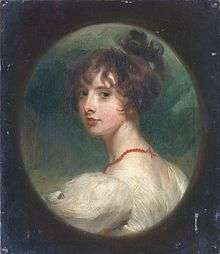 Portrait of Lady Emily Lamb, aged 16, by Sir Thomas Lawrence | |
| Spouse of the Prime Minister of the United Kingdom | |
| In office 6 February 1855 – 19 February 1858 | |
| Preceded by | The Countess of Aberdeen |
| Succeeded by | The Countess of Derby |
| In office 12 June 1859 – 18 October 1865 | |
| Preceded by | The Countess of Derby |
| Succeeded by | The Countess Russell |
| Personal details | |
| Born | Emily Lamb 1787 |
| Died | 1869 (aged 81–82) |
| Spouse(s) | Peter Clavering-Cowper Henry John Temple |
| Children | 5 |
| Parents | Peniston Lamb, 1st Viscount Melbourne Elizabeth Milbanke |
The Lamb family
Emily was born in 1787 to Peniston Lamb and his wife Elizabeth (née Milbanke). Due to her mother's numerous love affairs, her true paternity was never verified, and has been described as being "shrouded in mystery". The Lamb family had been politically prominent since the mid-18th century, reaching their zenith of influence in Emily's generation. Her father was made Viscount Melbourne in 1781. Her eldest brother William Lamb twice held the premiership of England, while another brother, Frederick Lamb, was a noted diplomat, and a third, George Lamb, was a minor playwright and journalist of the era. The Lambs were closely linked with the Whig party, and were intimates of Queen Victoria.[1] There was a lifelong bond between William and Emily, whom he fondly called "that little devil Emily"; by contrast she detested his wife, Lady Caroline Lamb (whom she called "the little beast").
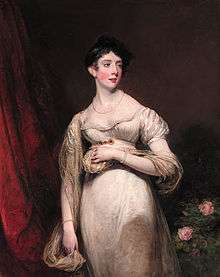
First marriage
Aged eighteen, Emily married Peter Clavering-Cowper, 5th Earl Cowper (1778–1837), who was nine years her senior. Lord Cowper had a reputation for dullness and slowness of speech which were in marked contrast to his wife's social gifts;[2] a more favourable opinion was that he was a quiet, pleasant man who was far less stupid than he appeared to be, but preferred to avoid society and politics.[3] Emily threw herself into the Regency social scene, becoming one of the patronesses of the highly exclusive Almack's club.[4] She was noted for kindness and generosity, and would do anything for a person she liked. She would even help people she disliked: although she detested her sister-in-law Caroline, when Caroline was barred from Almack's, a sign of the deepest social disgrace, Emily eventually managed to get the ban lifted.[5] Like many of the society ladies of the age, she had love affairs, including one with the Corsican diplomat Carlo Andrea Pozzo di Borgo, later Russian Ambassador to Great Britain.[6]
Emily was noted not only for beauty but for her extraordinary charm: she was described as "grace put in action, whose softness was as seductive as her joyousness". She was undoubtedly the most popular patroness of Almack's, her warmth and charm being a notable contrast to the rudeness and arrogance of some of the other ladies who ran the club, especially Lady Jersey and Princess Lieven.
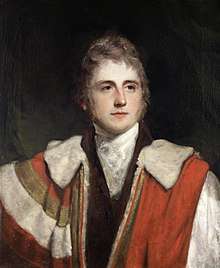
The affair with Palmerston
At Almack's, Lady Cowper was increasingly seen in the company of Henry John Temple, 3rd Viscount Palmerston, who was known as "Cupid" at the time for his various romantic dalliances, including affairs with Emily's fellow patronesses of Almack's, Dorothea Lieven and Sarah Villiers, Countess of Jersey. Palmerston was a regular fixture of her parties and salons, and as Lord Cowper sank into a long period of ill health and general decline, Lady Cowper and Lord Palmerston entered into a romantic relationship. This brought Palmerston, originally a Tory, increasingly in contact with notable Whigs, particularly Emily's brother. Of an 1826 proposal for Catholic Emancipation, Palmerston said, "the Whigs supported me most handsomely, and were indeed my chief and most active friends."[7] Soon after, Palmerston switched affiliations and ran as a Whig candidate. Emily's mother on her deathbed in 1818 urged her to remain constant to Palmerston, possibly looking forward to a future time when they would be free to marry.
Marriage to Palmerston

In 1837, Lord Cowper died, two days into the reign of Queen Victoria. This left the way open for a marriage between Emily and Palmerston, though their age was a cause for concern, as, in the eyes of her family, was Palmerston's reputation as a womaniser. The matter was referred to Queen Victoria, whose approval cleared the way for the marriage on 16 December 1839. Palmerston was 55 at the time, and Lady Cowper was 52.
They set up their home at Broadlands and the union was, by all accounts, a decidedly happy one. Of it, Lord Shaftesbury said, "His attentions to Lady Palmerston, when they both of them were well stricken in years, were those of a perpetual courtship. The sentiment was reciprocal; and I have frequently seen them go out on a morning to plant some trees, almost believing that they would live to eat the fruit, or sit together under the shade."[8]
During the marriage, Lady Palmerston continued an active social role as a salon hostess. As the events were eagerly attended by foreign diplomats, Lord Palmerston would encourage his wife to float his ideas before the assembled guests and report back on their reception as a means of unofficially testing the diplomatic waters before committing himself publicly to an opinion.[9] She could not cure his notorious lack of punctuality, since this was a fault she shared to the full; Queen Victoria, while staying with them at Broadlands, complained that Emily had kept her waiting for an hour for a carriage ride. It was a standing joke in London society that they were always so late for dinner that neither of them had ever heard of soup.
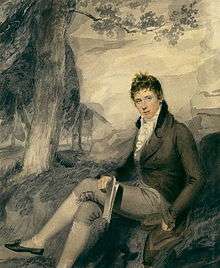
Death and children
In 1865, Lord Palmerston died, and Lady Palmerston followed him four years later. She was survived by her three sons and two daughters, all born during her marriage to Lord Cowper, although one of the daughters, Emily, was believed to have been fathered by Palmerston, and her son William may have been fathered by Pozzo di Borgo. They were:
- George Cowper, 6th Earl Cowper (26 June 1806 – 15 April 1856) he married Anne Florence Weddell, Baroness Lucas (daughter of Thomas) on 7 October 1833. They had six children.
- Lady Emily Cowper (1810 – 15 October 1872) she married Anthony Ashley-Cooper, 7th Earl of Shaftesbury on 10 June 1830. They had ten children.
- William Cowper-Temple, 1st Baron Mount Temple (13 December 1811 – 17 October 1888) he married Harriet Gurney on 27 June 1843. He remarried Georgiana Tollemach on 22 November 1848.
- The Honorable Charles Cowper (7 June 1816 – 30 March 1879) he married Lady Harriett Gardiner (daughter of Charles John Gardiner, 1st Earl of Blessington) on 1 September 1852. They had one daughter. He remarried Jessie McLean on 11 April 1871.
- Frances Jocelyn, Viscountess Jocelyn (1820 – 26 March 1880) she married Robert Jocelyn, Viscount Jocelyn on 9 April 1841. They had five children.
Arms
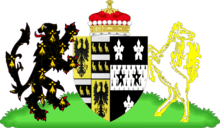 |
|
References
- Guedalla, Philip (1927). Palmerston: 1784–1865. New York: G.P. Putnam's Sons. pp. 233.
- Guedalla, 67.
- Ridley, Jasper Lord Palmerston Constable London 1970 p.43
- Moers, Ellen (1960). The Dandy: Brummell to Beerbohm. Lincoln: University of Nebraska Press. pp. 43–45. ISBN 0-8032-8101-3.
- Ridley p.48
- Ridley pp.43–4
- Quoted in Guadalla, 118–119
- Bolton, Sarah (1891). Famous English Statesmen of Queen Victoria's Reign. Boston: C.J. Peter's and Sons. p. 85.
- Bolton, pages 86–87
| Unofficial roles | ||
|---|---|---|
| Preceded by The Countess of Aberdeen |
Spouse of the Prime Minister of the United Kingdom 1855–1858 |
Succeeded by The Countess of Derby |
| Preceded by The Countess of Derby |
Spouse of the Prime Minister of the United Kingdom 1859–1865 |
Succeeded by The Countess Russell |
.svg.png)